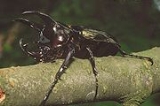
Atlas beetle
Encyclopedia
The Atlas beetle, Chalcosoma atlas, is a species of beetle
found in southern Asia
, especially Malaysia, remarkable for its size (25–130 mm). As common in some Scarabaeidae
, the male is larger than the female, and have specialised horns on the head and thorax that males use to fight with each other to gain mating rights with females.
of the Atlas beetle is known for its fierce behavior, including biting if touched. Unverified reports exist of larvae that live together fighting to the death if there's not enough space or food.
Beetle
Coleoptera is an order of insects commonly called beetles. The word "coleoptera" is from the Greek , koleos, "sheath"; and , pteron, "wing", thus "sheathed wing". Coleoptera contains more species than any other order, constituting almost 25% of all known life-forms...
found in southern Asia
Asia
Asia is the world's largest and most populous continent, located primarily in the eastern and northern hemispheres. It covers 8.7% of the Earth's total surface area and with approximately 3.879 billion people, it hosts 60% of the world's current human population...
, especially Malaysia, remarkable for its size (25–130 mm). As common in some Scarabaeidae
Scarabaeidae
The family Scarabaeidae as currently defined consists of over 30,000 species of beetles worldwide. The species in this large family are often called scarabs or scarab beetles. The classification of this family is fairly unstable, with numerous competing theories, and new proposals appearing quite...
, the male is larger than the female, and have specialised horns on the head and thorax that males use to fight with each other to gain mating rights with females.
Appearance
The Atlas beetle is, like other beetles of the genus Chalcosoma, notable for its size and the horns that is seen on its head. The Atlas beetle differs from other Chalcosoma species (such as C. caucasus) in the end of the cephalic horn of the Atlas, which is broadened.Larvae
The larvaLarva
A larva is a distinct juvenile form many animals undergo before metamorphosis into adults. Animals with indirect development such as insects, amphibians, or cnidarians typically have a larval phase of their life cycle...
of the Atlas beetle is known for its fierce behavior, including biting if touched. Unverified reports exist of larvae that live together fighting to the death if there's not enough space or food.

